St. Mark’s Basilica is one of Venice's most famous landmarks and a must-see for anyone visiting the city. Dating back to the 9th century, this stunning cathedral is steeped in biblical history and surrounded by captivating legends. Ranked as one of the top three attractions in Venice by Tripadvisor, it holds the remains of St. Mark and is celebrated for its remarkable blend of Byzantine, Romanesque, and Gothic architecture.
Recommended St. Mark's Basilica tickets
Basilica di San Marco is the epitome of Venetian aesthetics. Famous for its opulent design and gilded mosaics, it's affectionately known as "Chiesa d'Oro," or the "Church of Gold." Originally the Doge’s private chapel, it became the resting place of St. Mark's remains, brought from Alexandria to Venice in 829. Built to honor the saint, the basilica houses priceless artworks, relics, and stunning ornamentation. It's a must-visit for history lovers, artists, pilgrims, and tourists alike. Below are the top recommended St. Mark's Basilica tickets for an unforgettable visit.
How to skip the lines at St. Mark's Basilica
The wait time to enter St. Mark’s Basilica can range from 20 minutes to over an hour, depending on the time of day and season (April to October is the busiest). During high tide, St. Mark's Square often floods, making it uncomfortable to stand in line—especially with children, which can turn into quite a challenge.
While entry to the basilica itself is free, there are specific sections that require a fee. The basilica is divided into four main areas: St. Mark’s Museum, the Pala d’Oro, the Bell Tower, and the Treasury. Each section has a separate entry fee, and you’ll need to queue for each.
Now, imagine having to queue up every 15 minutes just to see different parts of one attraction—it’s cumbersome and can ruin the experience. That’s why we strongly recommend purchasing an online ticket that provides access to all parts of the Basilica in one go. This will save you time and energy, allowing you to spend more time exploring the Basilica and less time waiting in lines.
Skip the line + Guided tour ticket
This affordable ticket offers skip-the-line access along with a guided tour of St. Mark’s Basilica. With this ticket, you can bypass the long queues and explore the basilica with a certified guide. As you walk through the basilica, your guide will share fascinating legends and dive into its rich history, while showcasing the masterpieces of Byzantine art. This ticket grants access to all areas of the basilica except the Bell Tower.
History of St. Mark's Basilica
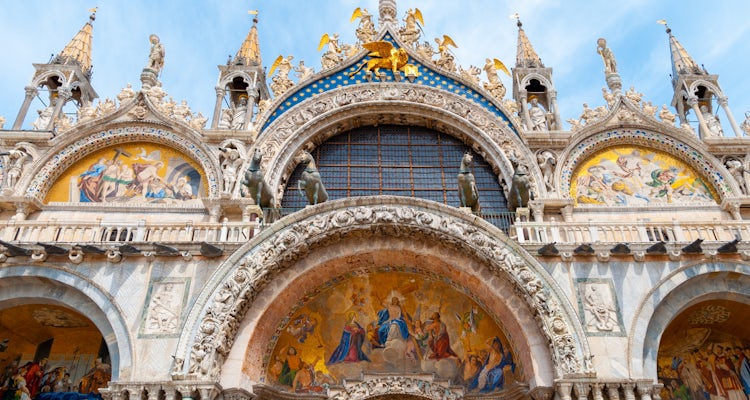
The story of St. Mark's Basilica is a fascinating one. In 828 AD, two Venetian merchants traveled to Alexandria on business. While there, they visited St. Mark’s sanctuary, which housed the saint’s body since his death. The sanctuary’s custodians revealed that the governor of Alexandria planned to demolish the site, prompting the merchants to ‘rescue’ St. Mark’s remains and bring them to Venice. They cleverly concealed the body in wicker baskets under pork meat, which, being considered haram in the Islamic state, allowed them to pass through the port without inspection.
Though they escaped the guards, they encountered a severe storm at sea. Miraculously, they survived and credited their safety to St. Mark himself.
Once they reached Venice, the relic was temporarily housed in a chapel within the Doge’s Palace for two years. In 832, a grand basilica was built near the palace to enshrine the relic, but this structure was destroyed in a fire during an uprising in 976. It was later rebuilt by Doge Domenico Cantarini, and by 1071, the basilica had regained its former glory. It has remained a symbol of magnificent grandeur ever since.
Be sure to notice the Mosaic of Porta di Sant'Alipio, the only surviving 13th-century mosaic on the basilica's exterior, which depicts this very story.
St. Mark's Basilica Architecture
North and South Façade
The South Façade, facing the water, was enclosed until 1503 and was originally used only for ceremonial purposes. It is adorned with mosaics and sculptures, making it a striking sight from the Grand Canal. Here, you can find a 13th-century Byzantine mosaic of the Virgin Mary between two griffins in the first arch. This side of the Basilica also features the Tetrarchs, a 4th-century statue made of red granite depicting four co-emperors of the Roman Empire, brought to Venice from Constantinople.
The North Façade, which faces the Piazzetta dei Leoncini, is home to the "Door of Flowers," also known as the Porta dei Fiori. This beautifully ornate doorway is framed by angels, foliage, and prophets. You’ll also find a painting of Alexander the Great’s chariot and an 8th-century depiction of the nativity scene with Mary, Joseph, and two oxen protectively watching over baby Jesus. Additionally, there is a carving of 12 lambs, representing the Apostles, flanking each side of the facade.
Exterior
The main entrance of St. Mark’s Basilica is located on its western facade, and its ornamental exterior is captivating at first glance. From here, you can admire the towering marble columns, domes, and intricate gold gilded carvings. The columns, each unique in color and pattern, decorate all four facades of the Basilica.
The Central Portal, made up of three arches, showcases the evolution of the Basilica’s architecture through the centuries. The innermost arch, from the Byzantine era, features intricate reliefs of foliage. The middle arch, representing the Gothic and Romanesque periods, illustrates allegories of the months and virtues. The outermost arch is adorned with carvings representing Venice’s guilds. A stunning mosaic of The Last Judgement is displayed on the outer arch, offering a vivid and colorful depiction of this biblical scene.
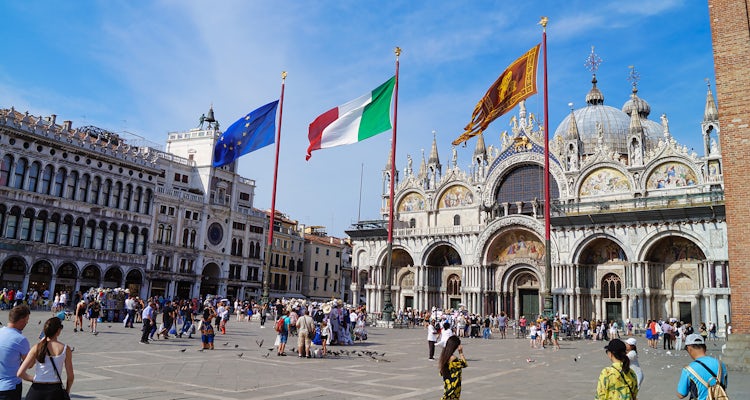
Interior
St. Mark’s Basilica is designed in the shape of a Greek cross and features stunning marble inlays on the floor, arranged in intricate geometric patterns and animal motifs. The interior is adorned with an astonishing 8,000 square meters of gilded mosaics covering the walls and ceilings—a surface area large enough to cover more than one and a half American football fields! The atrium is decorated with mosaic depictions of biblical scenes, featuring stories of the Virgin Mary, St. Mark, St. Clement, St. Peter, and St. John. The Basilica is supported by over 500 columns and capitals, most of which are Byzantine and date back to the 6th century.
Dome
St. Mark’s Basilica boasts five domes, all situated at the intersections of the Greek cross layout. Together, they span an area of 4,240 square meters. Each dome is 13 meters in diameter and contains 16 windows. These domes are richly adorned with golden mosaics, earning the basilica the nickname "Basilica d'Oro," or "Golden Basilica." The majority of these mosaics date back to the 1160s, with the oldest located above the choir. Each dome tells a specific story: The Creation (in the Narthex), The Pentecost (Western dome), The Ascension (Central dome), The Life of Saint John (Northern dome), and The Life of Saints Leonard, Nicholas, Clement, and Blaise (Southern dome). The best vantage point for viewing these magnificent domes is from the galleries near the museum.
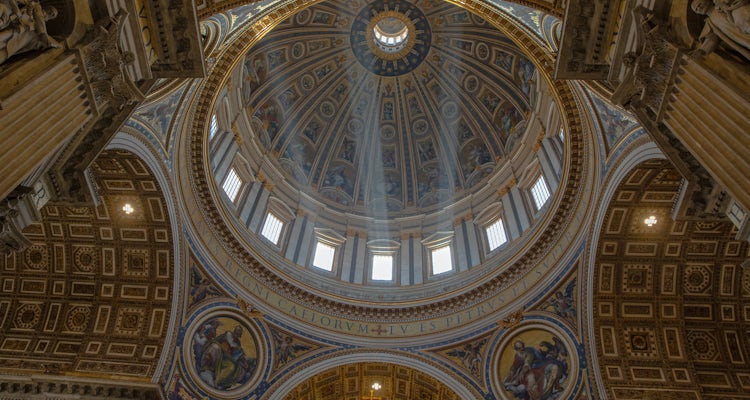
Transept Chapels
Transept Chapels Along the arms of the dome, several chapels are dedicated to different saints, each more exquisite than the last. Some of the most noteworthy include the Cappella della Madonna dei Máscoli, built in the 15th century, featuring a Gothic altar sculpture and intricate mosaic inlays. The Cappella di Sant'Isidoro is adorned with 14th-century mosaics and contains a sculpted stone coffin embedded in the wall, housing the remains of the saint. The Cappella della Madonna Nicopeia showcases the priceless Byzantine icon of the Madonna Nicopeia, adorned with precious stones in a delicate enamel frame. Lastly, the Cappella di San Clemente, once the Doge’s private chapel, is decorated with 12th-century mosaics. These are just a few of the many chapels within the Basilica, and a guided tour will offer deeper insights into their unique history and significance.
What to see inside St. Mark's Basilica?
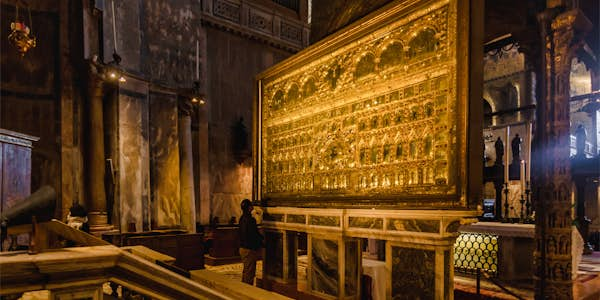
Pala d'Oro
The Pala d’Oro, meaning "Golden Cloth," is a masterpiece of Byzantine art, adorned with an astonishing 1,927 precious gems. This includes 526 pearls, 330 garnets, 320 emeralds, 255 sapphires, 183 amethysts, 175 agates, 75 rubies, 34 topazes, 16 carnelians, and 13 jaspers, all set among gold, silver, and cloisonné enamel plaques. This jewel-encrusted altarpiece depicts scenes from the life of Christ and took 366 years to reach its present form. If you enter St. Mark’s Basilica with a free ticket, you’ll need to purchase a separate ticket to view the Pala d’Oro.
Museo di San Marco
To reach the Museo di San Marco, head up the stairs from the Basilica's porch. The museum showcases an incredible collection, including liturgical objects, Persian carpets, fragments of mosaics (look out for the Tree of Jesse), golden tesserae, 78 relics of saints, and other treasures. A highlight of the museum is the Sala dei Banchetti, which displays luxurious fabrics and the Doge’s red velvet throne. The museum's most famous treasure is the Quadriga, four gilded bronze horses, often referred to as the Horses of San Marco. According to legend, these horses were stolen from Constantinople in 1204 and later displayed on the Loggia terrace, where Venetians marveled at them.
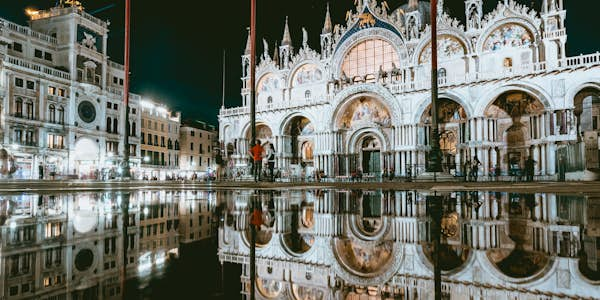
Treasury
The Treasury houses an extraordinary collection of precious artifacts, many of which were looted by the Venetians from Constantinople in 1204, alongside exquisite pieces created by ancient Venetian craftsmen. This series of rooms is one of the richest and most significant parts of the Basilica, displaying 283 gold and silver objects, along with many other fascinating treasures. Some highlights to look out for include crystal fish-shaped lamps, a cloisonné gold and silver box containing pieces of the True Cross, amphorae carved from a single block of agate, alabaster vases from Egypt dating to 300 BC, a perfume brazier in the shape of a small building with five cupolas, the throne of Doge Pietro Orseolo, St. George’s reliquary, a Byzantine icon of Archangel Michael, and a collection of medieval chalices made from precious stones like sardonyx, turquoise, enamel, and chalcedony.
Marble Inlays
The Basilica’s floor is a stunning mosaic of marble inlays, covering over 2,099 square meters. Designed in intricate geometric patterns, these inlays are predominantly earth-toned, with occasional animal and floral designs. You may even spot tiny pieces of glass embedded between the marble. As you explore, keep an eye out for depictions of foxes, peacocks, doves, roosters, and even a rhinoceros. This makes for a fun scavenger hunt for kids while you take in the Basilica’s rich history.
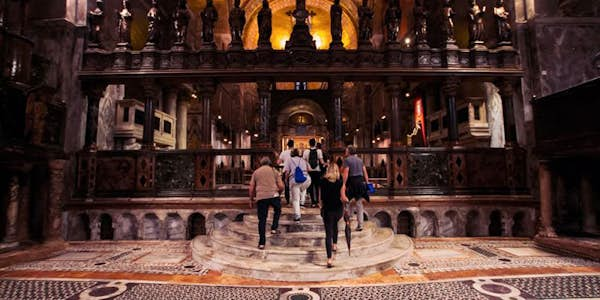
Tomb of St. Mark
The crypt, where St. Mark's body is believed to rest, is a special part of the Basilica that can be visited during tours outside regular hours. It is thought that this crypt was originally part of the first church built to safeguard St. Mark’s remains after they were brought from Alexandria. When the new Basilica was constructed above the original church, the burial site was transformed into a crypt, now a highly sought-after site for visitors. The crypt is beautifully adorned with mosaics, illuminated by soft lighting, while the walls show signs of erosion from centuries of flooding. Today, it continues to serve as a burial ground for the Patriarchs of Venice.
Know Before You Go
Getting to St. Mark's Basilica
St. Mark’s Basilica is located right in the heart of Venice’s main square, Piazza San Marco, also known as Saint Mark’s Square. It’s easily accessible by both foot and water transport.
By Public Vaporetto
To reach St. Mark’s Basilica by vaporetto (Venice’s public waterbus), take line #1 and get off at the “San Marco Vallaresso” stop, or line #2 and get off at “San Marco Giardinetti.” From there, it’s a short walk to Saint Mark’s Square. Once in the square, look for the Bell Tower, and right next to it, you’ll find St. Mark’s Basilica.
By Private Water Taxi
If you’re taking a private water taxi, ask the driver to drop you off at the “Todaro” landing stage. After you disembark, walk to Saint Mark’s Square. Look for the Bell Tower, and St. Mark’s Basilica will be right next to it.
On Foot
Reaching St. Mark’s Square on foot is straightforward. Once you arrive, simply look for the tall Bell Tower, and adjacent to it, you’ll find St. Mark’s Basilica.
St. Mark's Basilica Timings
- Mondays-Saturdays 9:30am - 5:15pm
- Sundays and holidays 2pm - 5:15pm
- Please note that during the months of March, April and days of festivals, the Church remains open until 5pm on Sundays. Monday through Saturday, the opening hours remain the same.
Mass Schedule at St. Mark's Basilica
Regular Mass Schedule:
- St. Mark's Basilica is open for prayer from 8am to 7:30pm
Daily Masses:
- Lauds and Terce Hour: 8:00 AM at the Chapel of San Teodoro
- Holy Mass: 8:30am and 10am
- Vespers and Office of Readings: 5:45pm at the Chapel of San Teodoro
- Rosary: 6:15pm
- Evening Holy Mass: 6:45pm
Saturday Masses:
- Vespers and Office of Readings: 5:45pm in the Choir
- Evening Holy Mass: 6:45pm in the Nave
Sunday & Solemnity Masses:
- Holy Mass: 8:30am and 10am in the Nave
- Solemn Mass: 10am (with choral accompaniment by the Cappella Marciana)
- Organ Mass: 12pm
- Vespers, Eucharistic Blessing, and Procession to the Madonna Nicopeia: 5:30pm
- Evening Holy Mass: 6:45pm in the Nave
Sacrament of Reconciliation:
- Available on weekdays from 10am to 12pm and from 6:30pm until the end of the evening Mass. Confession is also available on Saturday afternoons and Sunday mornings (except during Vespers and the Office of Readings).
Self guided route to explore St. Mark's Basilica
Before entering St. Mark's Basilica, take some time to admire the intricate exterior, with its ornate mosaics and detailed carvings. Once inside, begin your visit in the atrium, where you can marvel at the mosaic illustrations. Next, head up the steps to the Loggia, where you'll find the Museo di San Marco. After exploring the museum’s collection, step onto the terrace to enjoy a stunning aerial view of St. Mark's Square.
Once back down, take your time to explore the domes and chapels of the Basilica, paying close attention to the beautiful gilded mosaic floors. Continue your journey to the Treasury, followed by the breathtaking Pala d'Oro and the sarcophagus of St. Mark. After you've experienced all these areas, exit through the Northern Facade to complete your visit.
Insider Tips
- When visiting St. Mark’s Basilica, please dress modestly, as it is a place of worship. Visitors wearing shorts or tank tops will be denied entry.
- Avoid bringing large bags or tote bags, as these are not allowed inside, and the line for locker storage can be long.
- If you have binoculars, bring them along. Since photography is not permitted, binoculars will help you appreciate the intricate details and create lasting memories.
- The Basilica's interior is only illuminated between 11:30 AM and 12:45 PM on weekdays, and during liturgical celebrations on Sundays and holidays. Plan your visit during this window, as the mosaics can be difficult to fully appreciate without the extra lighting.
FAQs
Q. Is photography permitted inside St. Mark’s Basilica?
Q. Are there free visits to the St. Mark’s Basilica on selected days through the year?
Q. Any recommended route for a self guided tour of St. Mark’s Basilica?
Q. Is there a constraint on the time one can spend inside the Basilica?
Q. Are there Skip the Line entry only tickets to the Basilica?
Q. Will I have to wait in any sort of queues with my Skip the Line tickets?


